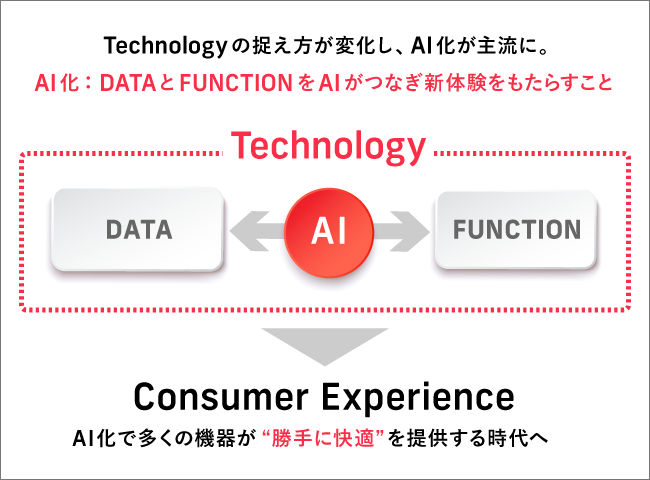The major turning points so far have been smartification and IoT integration.
This series explores the post-smartphone era. In this final installment, we'll examine the world "beyond" smartphones based on trends from CES (※1).
※1: The world's largest technology trade show held annually in Las Vegas
I have visited CES every year since 2011, reporting from various locations. During that time, two major turning points occurred.
The first was smartification. As smartphones became mainstream, tablets and smart TVs emerged, making it commonplace for all home appliances to connect to the internet.
Then, in 2015, the focus shifted from smart devices to IoT (connected devices). We entered an era where not just devices connect to the internet, but people and information connect with each other. However, has IoT truly advanced in our daily lives? Not really.
As introduced in Part 1, most people center their lives around smartphones. While communication is a primary use, smartphones are also used in various daily scenarios: checking directions to destinations, shopping, searching for information about things that catch their interest, and more.
The Smartphone-Free Era Has Already Begun
So, what lies ahead for smartphones, now so deeply embedded in our lives? Viewing CES through this lens reveals a market increasingly emerging without smartphones.
The integration between wearable devices (hereafter referred to as wearables) and smartphones, which was commonplace just a few years ago, is changing. With the advent of eSIMs (※2), devices can now connect directly to the cloud without relying on communication through a smartphone.
※2: Subscriber Identity Module (SIM) embedded within the device, eliminating the need for a physical SIM card.
Smartphone integration requires app development. Apps demand compatibility testing and updates for each device model. Considering individual variations, environmental dependencies, and battery issues, apps become a cost center.
Furthermore, the presence of apps often meant wearables came with unnecessary features and settings. If the device operates without an app, it must be ready to use immediately upon purchase, inevitably leading to simpler functions and operations. Updates can also be completed solely on the wearable, significantly reducing user hassle. However, challenges remain, such as the cost of the eSIM itself and the time required for wireless usage approvals (in Japan, the Technical Standards Compliance Certification), which involve not only cost but also time.
Another area where smartphones are becoming less essential is the smart home market. Previously, smartphones often served as remote controls or management devices, but the rise of smart speakers has largely eliminated this role.
Most products at CES now feature voice control capabilities. Furthermore, devices requiring no user interaction are rapidly increasing, with AI serving as the underlying technology.
Two Types of AI Utilization: Input-Based and Output-Based
A major shift in AI utilization was also a defining feature of CES 2019.
Previously, AI usage was mainly limited to recognition-type AI focused on specific domains like voice or image recognition. These were often used as interfaces to execute specific actions.
Now, products and services utilizing diagnostic AI—an evolution beyond recognition AI—are becoming commonplace. For instance, some offer personalized solutions or product recommendations based on skin type or body shape diagnostics.
If recognition-based AI is considered the Input, then diagnostic AI is the Output. While these were traditionally offered as separate services, CES showcased numerous products and services where this Input and Output are now seamlessly integrated.

Recognition-type AI and diagnosis-type AI seamlessly
When Input and Output become seamless, humans no longer need to operate systems manually. Automatic feedback enables the delivery of diverse experiences.
For example, if there's an Input that automatically collects information about ingredients in the refrigerator, it will recommend recipes utilizing those ingredients at lunchtime. While refrigerators haven't yet evolved to cook meals, home appliances that automatically produce items like beer, hand cream, and perfume have appeared. Combining AI with such devices will enable them to automatically create items tailored to your preferences.
Currently available devices like air conditioners and air purifiers are prime examples of automatically providing comfortable spaces. Some high-end air conditioners use motion sensors and thermometers to detect human comfort levels, directing warm air to areas where someone feels cold and automatically switching to a maintenance mode when a comfortable state is detected. This is an area where the concept of manual operation is clearly fading.
Mobility devices like automobiles automatically gather surrounding information to prevent collisions. Personal mobility devices, such as carts, not only avoid collisions with people but also detect obstacles like steps and ditches, automatically preventing falls. Some smart homes now offer services that automatically detect abnormalities in residents and call emergency services.
These systems collect data via sensors, which AI then analyzes to activate specific functions. Previously, since AI wasn't involved, people had to manually activate functions using remotes or smartphones based on the situation.
Beyond Digitalization: The Era of "Automatic Comfort"
Moving forward, AI will autonomously provide comfort tailored to each individual. In the near future, automatically delivered comfortable environments will become the norm. As discussed in our AI speaker survey, this situation confirms that a future where even picking up a smartphone to operate something becomes a hassle is fast approaching.
AI integration means combining AI with devices that create objects and environments. These AI-integrated devices might not even require voice commands, let alone smartphones.
I define this AI evolution beyond digitalization as the "Automatic Comfort" era. In a future where "Automatic Comfort" is the norm, smartphones may simply become devices for browsing information and content.
While it may be difficult to grasp this future now, when we still can't part with our smartphones, the post-smartphone era will likely bring even more new business opportunities than the period when smartphones first became widespread.


Book now available! Details
here.








